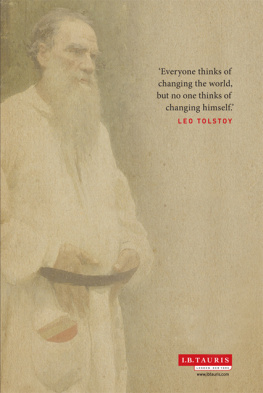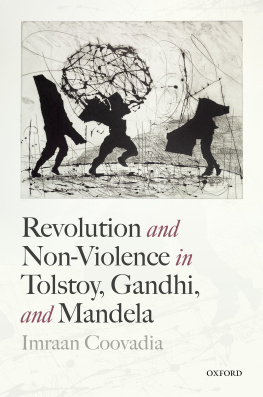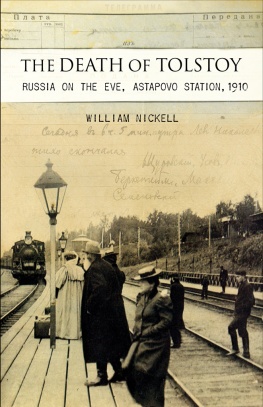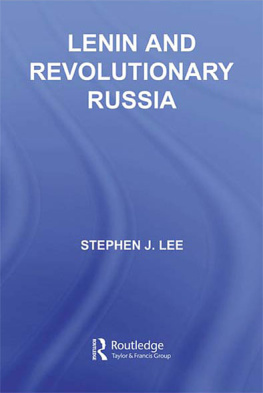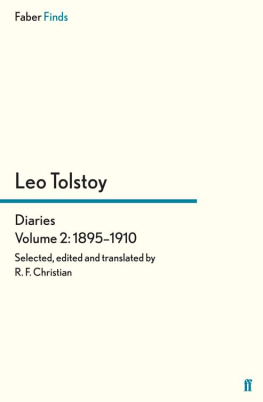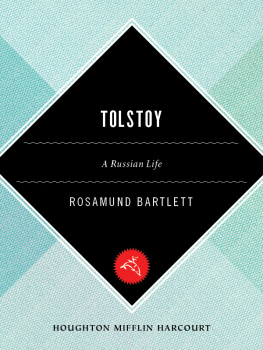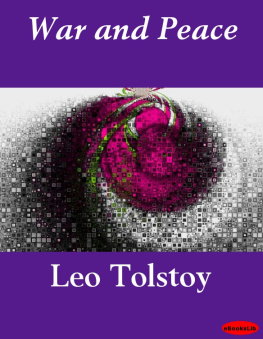
Charlotte Alston is Senior Lecturer in History at Northumbria University, Newcastle upon Tyne. She is the author of two other books: Russias Greatest Enemy? Harold Williams and the Russian Revolutions (I.B.Tauris, 2007); and Piip, Meierovics, Voldemaras: The Baltic States. Makers of the Modern World, the Peace Conferences of 191923 and their Aftermath (2010). She has published journal articles and book chapters on Russias relations (both cultural and diplomatic) with the West, the history of the Russian revolution and the Russian civil war, the post-First World War peace settlements, and the international influence of Tolstoys thought.
TOLSTOY AND
HIS DISCIPLES
The History of a Radical International
Movement
C HARLOTTE A LSTON

Published in 2014 by I.B.Tauris & Co Ltd
6 Salem Road, London W2 4BU
175 Fifth Avenue, New York NY 10010
www.ibtauris.com
Distributed in the United States and Canada
Exclusively by Palgrave Macmillan
175 Fifth Avenue, New York NY 10010
Copyright 2014 Charlotte Alston
The right of Charlotte Alston to be identified as the author of this work has been asserted by her in accordance with the Copyright, Designs and Patents Act 1988.
All rights reserved. Except for brief quotations in a review, this book, or any part thereof, may not be reproduced, stored in or introduced into a retrieval system, or transmitted, in any form or by any means, electronic, mechanical, photocopying, recording or otherwise, without the prior written permission of the publisher.
International Library of Twentieth Century History 9
ISBN: 978 1 84511 261 5
e-ISBN: 978 0 85773 592 8
A full CIP record for this book is available from the British Library
A full CIP record is available from the Library of Congress
Library of Congress catalog card: available
For Gareth and Ifan
TABLE OF CONTENTS
ACKNOWLEDGEMENTS
I am very grateful to the following research councils, academies and institutions, who provided financial support for this project. The British Academy funded research trips to archives in Moscow, New York, New Haven and Michigan through their small grants scheme. The Royal Irish Academy and the Hungarian Academy of Sciences awarded me a visiting fellowship under their exchange scheme, which enabled me to work in the Szchnyi National Library in Budapest. The Arts and Humanities Research Council funded a period of research leave for the completion of this book. The University of Ulster and Northumbria University generously funded additional research trips to Moscow and Amsterdam.
The convenors and audiences of the following seminars and conferences, at which I presented papers based on the research for this book, all gave me really excellent feedback and helped to shape my ideas: the seminar in Russian Cultural and Historical Studies at Durham University; the Anarchist Studies seminar at Loughborough University; the History Department seminar at the University of York; the Sites of Internationalism workshop at Northumbria University; the Study Group on the Russian Revolution (2007); the Anglo-American Conference of Historians (2008); the Institute of English Studies conference on Russia in Britain (2009) and the Association for Slavic, East European and Eurasian Studies annual conference (2010).
Many colleagues, archivists, librarians and friends have helped me during the research and writing of this book. Peter Berg at Michigan State University Library, Richard Davies at the Leeds Russian Archive, Vlada Gaiduk at The Russian State Archive of Literature and Art (RGALI) and Svetlana Novikova at the State Museum of Leo Tolstoy in Moscow were all enormously helpful during research trips to their archives. Kaarina Noble and Rosemary Mitchell-Schuitevoerder helped me with the translation of materials from Finnish and Dutch. Alexander Christoyannopolous, Wim Coudenys, Stuart Eagles, Irina Gordeeva, Luke Kelly, Gary Muir and Nigel Todd all discussed their research with me and shared leads or materials. Bracken Gibson spoke to me about the history of the Brotherhood Church at Stapleton. Sasha Handley did some really vital last-minute research for me in Manchester. Sasha and Rachael Wiseman also helped me to write this book by working really industriously (or appearing to) on their own projects on our study days. Gareth Prosser encouraged me to start on this project when we first discussed it in 2006, and has listened to more Tolstoyan dilemmas than anyone outside this book would want to. He also read and commented on the manuscript. Daniel Laqua, David Saunders and Avram Taylor also kindly read chapters of this book and made really useful comments on them. I am very grateful to Lester Crook and Tomasz Hoskins at I.B.Tauris for commissioning the book and their patience while I delivered the manuscript. Any errors or deficiencies in this book are my responsibility entirely.
NOTE ON TRANSLITERATION
The Russian names for places and people used in this book are transliterated according to the Library of Congress system, without diacritical marks. The only exceptions are names which have a particularly well-known and accepted western equivalent; for example: Tolstoy, Yasnaya Polyana and Doukhobor. In general, I have sought to present names as they would appear in the individuals home country so, for example: Duan Macovick, not Dushan Makovitskii; Jen Henrik Schmitt, not Eugene Heinrich Schmitt; and Frantiek Sedlk, not Francis Sedlak.
INTRODUCTION
Between 1880 and his death in 1910, Tolstoy produced a body of work in which he outlined his philosophy of life. He had come to believe in a form of primitive Christianity, based on the principles of brotherhood, non-violence and non-resistance to evil by violence. He rejected the state (which could only exist on the basis of physical force) and all institutions that derived from it the police, law courts, the army and the Russian Orthodox Church. He condemned private property and money, and advocated living by one's own physical labour. He also came to believe in vegetarianism, complete chastity, and abstinence from tobacco and alcohol. Tolstoy's attempts to put his beliefs into practice, his frustration at his inability to do so and his wife's hostility to his extreme views and his followers, led to tension in his family life in his last years and his eventual departure from home days before his death in the autumn of 1910.
Tolstoy's fate attracted world-wide interest. His philosophy, however, had an impact of its own on groups and individuals who were disillusioned with modern industrial society and with the politics of the time. His most dedicated followers developed correspondence networks and set up newspapers, publishing houses and agricultural colonies devoted to living a Tolstoyan life. In Russia, Tolstoyan colonies were established during Tolstoy's lifetime, and they developed a new lease of life in the years after the revolution. Centres of Tolstoyan activity emerged in Britain, the United States of America, the Netherlands, Finland, Hungary, Japan, South Africa and Chile. They were connected on a local level to a wide variety of reform movements, including: vegetarianism, animal rights, industrial cooperation, anarchism and communitarianism. This book explores the origin, activities and beliefs of some of the individuals and centres that made Tolstoyism an international movement.
Tolstoy himself strenuously denied the existence of a specifically Tolstoyan movement. His emphasis on attacking rigid doctrine meant that the emergence of groups of people who attempted to live according to his blueprint for life was painfully at odds with what he was trying to achieve. To speak of Tolstoism, to seek guidance, to inquire about my solution of questions, is a great and gross error, he wrote.
Next page
